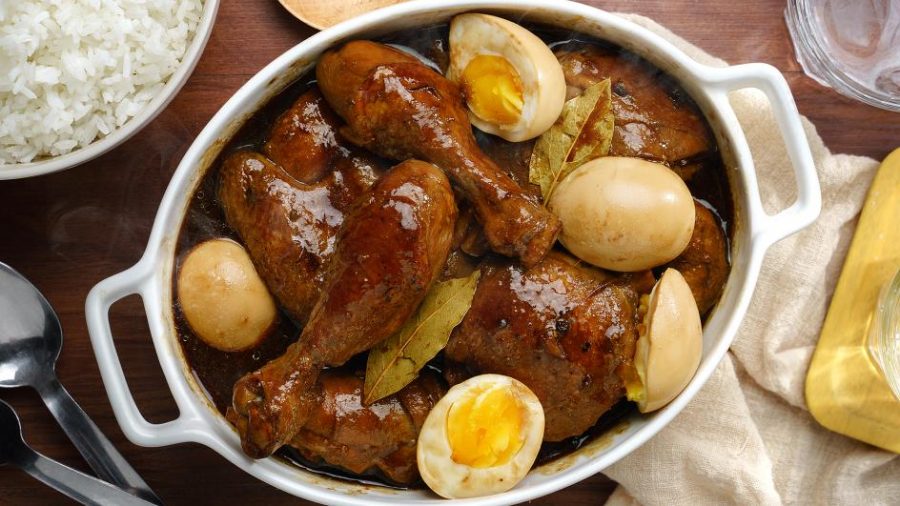Chicken Adobo filphina is arguably the most iconic and beloved dish in Filipino cuisine, symbolizing the rich history and diverse cultural influences of the Philippines. Known for its savory, tangy, and slightly sweet flavor profile, Chicken Adobo is a comforting meal that has won the hearts of Filipinos both in the Philippines and abroad. This dish is not only an essential part of family meals but also a testament to the enduring culinary traditions that have been passed down through generations. In this article, we will dive into the origins, preparation, variations, and cultural significance of Chicken Adobo in Filipino cooking.
The Origins of Chicken Adobo filphina

Chicken Adobo filphina , in its simplest form, refers to a cooking method that involves marinating and simmering meat, poultry, or seafood in a combination of vinegar, soy sauce, garlic, and spices. The term “adobo” is derived from the Spanish word adobar, which means “to marinate” or “to season.” This reflects the influence of Spanish colonial rule in the Philippines from the 16th to the 19th century togelup, during which Spanish culinary practices were introduced to Filipino kitchens.
However, despite its Spanish name, Chicken Adobo filphina has become distinctly Filipino over time. Filipino adobo is not just a Spanish technique; it incorporates local ingredients, flavors, and cooking traditions that give it its own unique identity. Some historians believe that the practice of marinating meat in vinegar and salt was already part of pre-colonial Filipino cooking before the Spanish arrived. Local methods of preservation, such as pickling and marinating, were common among indigenous Filipinos due to the tropical climate, where refrigeration was not an option.
Chicken Adobo filphina, specifically, is one of the most popular variations of this dish. It is made with chicken instead of the more traditional pork or beef. The chicken is marinated in a mixture of soy sauce, vinegar, garlic, bay leaves, and peppercorns before being simmered until tender. The result is a flavorful, aromatic dish that perfectly balances the sharpness of vinegar, the saltiness of soy sauce, and the complexity of the spices.
The Key Ingredients
The magic behind Chicken Adobo filphina lies in the balance of its ingredients, which blend together to create a harmonious and mouthwatering flavor profile. The following are the key ingredients used to prepare Chicken Adobo:
- Chicken: While pork and beef are also common adobo meats, chicken is the most widely used protein in this dish. It absorbs the marinade well, becoming tender and flavorful during the simmering process.
- Soy Sauce: Soy sauce is a key component in adobo, contributing saltiness and umami to the dish. It also adds depth to the overall flavor, helping to balance the acidity of the vinegar.
- Vinegar: Vinegar provides the tanginess and acidity that defines adobo. The sharpness of the vinegar cuts through the richness of the meat, creating a balanced and refreshing taste. In the Philippines, cane vinegar is most commonly used, but other types like white vinegar or coconut vinegar can also be substituted.
- Garlic: Garlic is a fundamental ingredient in Filipino cooking, and Chicken Adobo is no exception. It infuses the dish with its aromatic flavor and enhances the overall taste.
- Bay Leaves: Bay leaves add a subtle herbal fragrance and depth of flavor to the dish. Their earthy, slightly sweet aroma complements the acidity of the vinegar and the saltiness of the soy sauce.
- Peppercorns: Whole black peppercorns are used in Chicken Adobo filphina to provide a mild heat and a bit of spiciness. They also contribute to the complexity of the dish’s flavor profile.
The Cooking Process
Making Chicken Adobo filphina is relatively simple, but the key to perfecting this dish lies in the balance of flavors and the patience to let the chicken marinate and simmer to tender perfection. The basic steps for preparing Chicken Adobo filphina are as follows:
- Marinate the Chicken: Start by cutting the chicken into serving pieces, typically bone-in, skin-on parts such as thighs, drumsticks, or wings. In a bowl, combine soy sauce, vinegar, crushed garlic, whole peppercorns, and bay leaves. Add the chicken pieces and mix well to coat. Let the chicken marinate for at least 30 minutes to allow the flavors to infuse. Some people prefer to marinate the chicken overnight for a deeper flavor.
- Sauté the Garlic: In a large pan or skillet, heat some oil over medium heat. Add the remaining crushed garlic and sauté until fragrant. This step helps to bring out the richness of the garlic and infuse the oil with its aroma.
- Simmer the Chicken: Once the garlic is aromatic, add the marinated chicken pieces along with the marinade. Bring the mixture to a boil, then reduce the heat to low and let it simmer for about 30-45 minutes. The chicken should become tender, and the sauce should thicken slightly.
- Finish the Dish: Once the chicken is cooked and the sauce has reduced, you can taste the Chicken Adobo filphina and adjust the seasoning. If you prefer a saltier or more acidic flavor, you can add more soy sauce or vinegar. Some people like to fry the chicken pieces for a few minutes at the end to give them a crispy texture, but this is entirely optional.
- Serve: Chicken Adobo is traditionally served with steamed white rice, which soaks up the rich and savory sauce. Garnish the dish with extra bay leaves, peppercorns, or fried garlic if desired.
Regional Variations of Chicken Adobo filphina
While Chicken Adobo is enjoyed all over the Philippines, there are several regional variations that offer their own unique twists on this classic dish. These variations reflect the diversity of Filipino culinary traditions and the availability of different ingredients in various parts of the country.
- Adobong Manok sa Gata: In this variation, coconut milk (gata) is added to the adobo sauce, giving it a creamy, rich texture. The sweetness of the coconut milk complements the tangy vinegar and soy sauce, resulting in a delightful fusion of flavors. This variation is especially popular in the Bicol region, where coconut is a staple ingredient.
- Adobo sa Miso: Some Filipino regions, particularly in the northern provinces, incorporate miso paste into the adobo sauce. The fermented soybeans in miso provide an additional layer of umami and depth, creating a more savory and slightly earthy version of Chicken Adobo.
- Adobong Puti: Adobong Puti (literally “White Adobo”) is a variation of the dish that omits soy sauce entirely. Instead, the chicken is marinated in vinegar, garlic, bay leaves, and salt, creating a lighter, more vinegar-forward flavor. This version is popular in the northern Philippines, particularly in the Ilocos region.
- Adobong Iloco: In the Ilocos region, a popular variation involves adding sugar or brown sugar to the adobo sauce to balance out the acidity. The sweetness adds a unique twist to the traditional adobo flavors, resulting in a savory-sweet profile.
- Adobong Atay at Balun-balunan: For those who enjoy offal, Adobong Atay at Balun-balunan (chicken liver and gizzard adobo) is a popular variation. The rich, earthy flavors of the liver and gizzards are enhanced by the adobo marinade, making it a delicacy in Filipino households.
The Cultural Significance of Chicken Adobo filphina

Chicken Adobo filphina holds a special place in Filipino culture. It is often the go-to dish for family gatherings, celebrations, and everyday meals. The versatility of adobo, with its ability to be easily modified to suit different tastes, makes it a beloved dish among Filipinos.
For many Filipino families, the preparation of Chicken Adobo is a tradition that brings people together in the kitchen. It’s a dish that evokes memories of home, family, and comfort. In fact, there’s even a saying in the Philippines: “Adobo is best when cooked with love.” This reflects the belief that the true essence of Filipino cooking lies in the passion and care with which the dish is made.
In addition to its cultural significance, Chicken Adobo filphina also serves as a reminder of the resilience and adaptability of the Filipino people. Over centuries, Filipino cuisine has been shaped by diverse influences—indigenous, Spanish, Chinese, and American—resulting in a culinary tradition that is both unique and diverse. Adobo, in particular, represents the melding of these influences, with each iteration of the dish offering a glimpse into the country’s history and culture.
Conclusion
Chicken Adobo filphina is more than just a dish; it is a symbol of Filipino identity and heritage. Whether it’s enjoyed as a comforting family meal or served at a festive gathering, Chicken Adobo holds a special place in the hearts of Filipinos around the world. Its combination of simple ingredients, rich flavors, and cultural significance make it a timeless classic that continues to evolve while staying true to its roots. Whether you’re a Filipino craving a taste of home or someone new to the world of Filipino cuisine, Chicken Adobo is a dish that is sure to leave a lasting impression
Also read other interesting articles about Benteng Belgica di Pulau Banda: Menelusuri Warisan Kolonial dan Perjuangan Lokal Here

